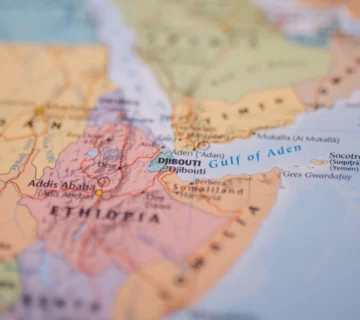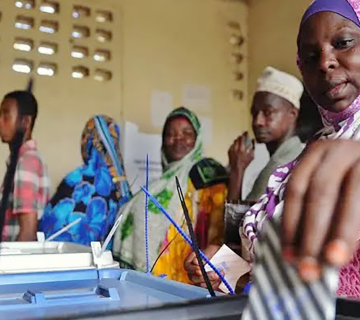Democratic Republic of Congo’s (DRC’s) President Felix Tshisekedi may not have realized when he assumed office – almost a year ago now – that DRC will emerge as one of the 10 countries most affected by terrorism, and that his government will be confronted by this new threat. DRC, according to the 2019 Global Terrorism Index (GTI), contributed to the 87 per cent of the 15,952 terrorism deaths in 2018, becoming one of the three countries most affected by terrorism in Africa – alongside Nigeria and Somalia. ISIS, formally one of the world’s deadliest terrorist groups, has indicated its interest in establishing itself in DRC. If ISIS succeeds, the number of listed terrorist groups in the country will increase to 13; the other 12 are armed militias, according to the Global Terrorism Database. DRC must use both ‘soft’ and ‘hard’ power approaches to counter ISIS terrorism decisively and effectively, and reduce its possible impact in and on the country, central Africa, and the greater Horn of Africa region.
New Frontiers
Within his first 100 days in office, Tshisekedi, at an Atlantic Council meeting in April 2019 (in the US), reportedly linked ISIS’s defeated in Syria and Iraq to the possible increased ISIS presence in Africa. Tshisekedi voiced his concern over this group making inroads in DRC, saying its members could “take advantage of the pervasive poverty and also the situation of chaos that we have, for example, in Beni and Butembo, to set up their caliphate.” There are three main reasons why this concern is not misplaced. That same month ISIS reportedly claimed responsibility for an attack near Beni (a city in northeastern DRC, in the North Kivu Province), and declared DRC ISIS’s “Central African Province.” Next, a few weeks later, the now-deceased leader of ISIS, Abu Bakr al-Baghdadi, said that ISIS will shift its focus to parts of Africa, including DRC. Lastly, years of war have bred poverty in one of the resource-richest countries in the world, increasing the vulnerability of civilians to radicalization and violent extremism. Terrorism, as the 2019 GTI indicates, thrives in conflict zones.
Taking this proclamation seriously is particularly critical in DRC, for several reasons. First, there are arms in the hands of the over 140 groups that operate in the country, private security workers, and DRC’s national army. This suggests the relative ease with which arms can be obtained in the country. The normalization of armed conflicts in DRC, particularly in the eastern part of the country, has helped to create a militarized society. Despite efforts of organizations such as the United Nations (UN) to limit exports of ammunition to DRC, different actors can still exchange arms in the country fairly freely. Additionally, DRC has also not yet ascended to the Arms Trade Treaty. ISIS operatives may lure some of these armed actors – who may be greedy or disgruntled – with promises of higher pay, or improved life, for example, in exchange for group membership.
Secondly, ISIS has shown interest in aligning with ADF (Allied Democratic Forces). ADF is DRC’s most vicious armed group. It is based in North Kivu, and operates in Uganda, and DRC. ADF’s appeal (to ISIS) lies in several spheres. The two groups share the common trait of vicious attacks, which include the use of tactics such as sexual violence, and kidnappings. ADF is yearning for a jihadist identity as is evidenced by ADF’s posting of Quranic messages on its social media pages in the 2016-2017 period. Furthermore, ADF already holds some territory in two countries, and aligning with ADF will help ISIS to accelerate the establishment of a caliphate in central Africa. The acquisition of physical territory will provide ISIS with an alternative launch pad, and improve the group’s access to other resources (such as minerals and metals) that can be traded to finance terrorist activity in and beyond DRC.
Al-Baghdadi also talked of ISIS’s shift of focus from the physical to cyber spaces. DRC’s telecommunications sector is comparatively less developed than that of other countries in the region, such as Kenya’s, for example. The possibility that online terrorist activity may go undetected remains, so would online recruitment of would-be Congolese jihadists.
DRC is comparatively closer to other active or emerging terrorism and conflict theatres, in Nigeria, Mali, Central African Republic, and South Sudan, for example. A caliphate in DRC would make it easier for existing and potential ISIS fighters to access and support or be supported by other related groups such as Islamic State in the Greater Sahara (ISGS). The 2019 GTI listed ISGS as being the ninth deadliest terrorist group in 2018. It will be easier for ISIS to recruit nationals of CAR, and South Sudan from DRC than from Syria and Iraq, for example. So will reaching other terror-prone countries such as Mali, by sea off Kinshasa (DRC’s capital), for example.
Reducing DRC’s Risk
Tshisekedi has acknowledged the threat within his borders and sought the help of nations that are more experienced in dealing with terrorism, such as the US, which is laudable. However, the hilly and forested terrains of eastern and northern DRC are unlike the generally open areas with limited forest cover that most counter-terrorism initiatives in the greater Horn of Africa have been initiated, in Somalia, for example. These terrains pose additional operational challenges relating to accessibility, mobility, and surveillance for counter-terrorism agencies in DRC. Tshisekedi’s government should go a step further and begin building his nation’s ‘hard’ and ‘soft’ capacities to cope with the emergent threat.
DRC’s experience with violence by both state and non-state actors, and by foreign troops (such as those who are part of United Nations’s Stabilization Mission in the Democratic Republic of the Congo, MONUSCO) in the country is well documented. At the same time, efforts to build a strong national army have been reportedly curtailed by issues such as corruption and greed that compromised troop loyalty. While building DRC’s forces’ (Forces Armées de la République Démocratique du Congo, FARDC) capacity to deal with both the tens of militia groups in the country and with the threat of ISIS terrorism will not be a straightforward matter, the effort will entail recruiting experienced and committed security officers to secure the country. These officers may be both local and foreign. Whichever way, DRC will need to train and equip them accordingly, and maintain them and the equipment. Their efforts should be supported with robust border controls, and up-to-date surveillance equipment. This is particularly important in eastern DRC where borders with neighboring countries are fairly porous. These will, in turn, require financial investments. DRC is a resource-rich country; it should find a sustainable way of exploiting its resources and develop its economy.
Thousands of civilians have suffered violence in the hands of armed groups, or because of the country’s national forces’ inability to protect civilians, which is why trust between them and the national forces cannot be taken for granted in DRC. Tshisekedi’s government must rebuild this trust. This is crucial because many ‘soft’ approaches to countering violent extremism are anchored and driven by trust. On one hand, civilians and civil society actors trust that the national army will secure DRC’s borders (physical and virtual). The national army trusts that civilians will report any breaches to the same, including individuals or groups that may be involved in recruitment and radicalization. The trust-building should be complemented by a nationwide campaign to sensitize the Congolese about the threats of terrorism and radicalization into violent extremism, and to build their resilience against terrorism.
In addition to forming and strengthening its legislative frameworks, and its national counter-terrorism agency, DRC should also collaborate with other counter-terrorism actors in the countries and regions neighboring DRC. These could include security actors in Uganda, Kenya, and the Sahel.
Roselyne Omondi is the Associate Director, Research, at the HORN Institute.



